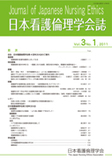Japanese
English
- 販売していません
- Abstract 文献概要
- 参考文献 Reference
- サイト内被引用 Cited by
本研究は、「ケア対象者の安全・安楽・尊厳を保証する抑制・身体拘束ケアガイドライン」の作成を目的としている。その一部として、本稿では、看護者の抑制実施時の倫理的判断と抑制実施時に「説明」を重視する看護者の特徴について述べた。1,260名の看護者対象にアンケート調査を行い、回答の得られた777名を分析対象とした(有効回答率61.7%)。分析の結果、抑制実施時に悪影響を最小限にすることを重視する看護者が多く、抑制中のケアでは、日常生活援助やケア対象者への支援が多かった。「説明」を重視する看護者と重視しない看護者の、責任との関連については、〈悪影響を最小限にする〉〈関係性の破綻を来さない〉責任が、判別の要因として抽出された。
The present study aimed to develop nursing intervention guidelines for the use of physical restraints in order to ensure patient safety during nursing care while at the same time maintaining patients' dignity based on sound clinical and ethical judgments. First, ethical judgments regarding the use of physical restraints and characteristics of nurses who provide explanations to patients regarding physical restraints were clarified. A questionnaire was distributed to 1260 nurses and a total of 777 valid responses were analyzed. The results revealed that most nurses utilized physical restraints in order to minimize negative patient behaviors. Many nurses indicated that physical restraints were used for “daily life support”, “emotional support”, and “supporting families”, whereas few nurses used physical restraints to “support staff”. A total of 664 nurses indicated that they provided “explanations” to patients when using physical restraints; 113 nurses indicated that they did not provide explanations. The minimization of negative patient behaviors and the prevention of the failure of relationships were extracted as important factors in the responsibility of nurses towards patients with regard to the use of physical restraints.
Copyright © 2011, The Japan Nursing Ethics Associatin. All rights reserved.


